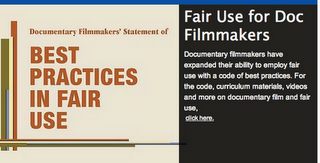Amanda,
Copyright is confusing and will always be something society will question. In your post, you stated "As technology grows and changes, transforms the way people create and view their cultural relevance." I totally agree. As technology and this world changes, people will also have to change to adapt. The whole copyright issue is something I know about, school has beat it in my head but yet they never really explained why. We were just told you cannot violate copyright laws.
Creative Commons is a lifesaver for some. Copyright is still confusing to some people. In education, I just want to use a picture in my blog post for class and give credit to where I got it from. Some people may see it as illegal even though I referenced where I got it from. It is mind-boggling to me. After all the videos and articles I read on the issue, I am still a little confused because everyone has their perception on copyright.
Copyright is confusing and will always be something society will question. In your post, you stated "As technology grows and changes, transforms the way people create and view their cultural relevance." I totally agree. As technology and this world changes, people will also have to change to adapt. The whole copyright issue is something I know about, school has beat it in my head but yet they never really explained why. We were just told you cannot violate copyright laws.
Creative Commons is a lifesaver for some. Copyright is still confusing to some people. In education, I just want to use a picture in my blog post for class and give credit to where I got it from. Some people may see it as illegal even though I referenced where I got it from. It is mind-boggling to me. After all the videos and articles I read on the issue, I am still a little confused because everyone has their perception on copyright.
Week 1: Copyright Issues
Image courtesy of (2008) MikeBlogs.
Some rights reserved.
After viewing and reading the articles provided to us about copyright it is hard to wrap my head around how this term or law has changed and continue to change the way we share, view and create information, art, and media.
I had never particularly paid attention to some of these laws and what they truly meant. This topic has really opened my eyes to a concept that was something I had never known much about as well as Creative Commons, which seems to simplify this ever changing and relatively outdated law.
Screenshot of “A Shared Culture,”
by Jesse Dylan.
I think Creative Commons was created out of the necessity for all of the confusing copyright infringements that can happen unknowingly. Larry Lessig’s ideas were an essential step forward to help with this massive law. As technology grows and changes, transforms the way people create and view their cultural relevance. So changes in these copyright laws and new Creative Commons is inevitable and will continue to impact how media and art is shared to suit these every changing needs.
Screenshot obtained from centerforsocialmedia.org/fair-use
The notion of Fair Use was intended to provide a safe guard so that copyrighted material can be used or reshown but only in limited and vague circumstances. Which can seem a bit confusing. So with the notion that, yes this term Fair Use apply and doesn’t apply to situations you may have once thought, brought fourth a Fair Use best code practices guide to help the creator, figure out some of the Fair Use Practices that are applicable to the content the creator is using to recreate his or her own work.
The case with Shepard Fairey seems to fall under these inconspicuous Fair use practices but many people fall on either side of the spectrum with this case especially because of the earlier work Fariey has created as well as not providing credit to the original artist.
Screenshot of Larry Lessig's TED Conference
This topic has undoubtedly been an eye opening learning experience to the laws and how I look at material viewed or created. One point that stood out particularly and can really apply to whole idea of copyright was given by Larry Lessig in his TED conference, describing the term “Democratize” which is roughly described that “anybody with access that can take sounds and images from culture to recreate and say things differently. Theses tools of creativity have become tools of how our kids think, speak, and their relationship to themselves.”




No comments:
Post a Comment